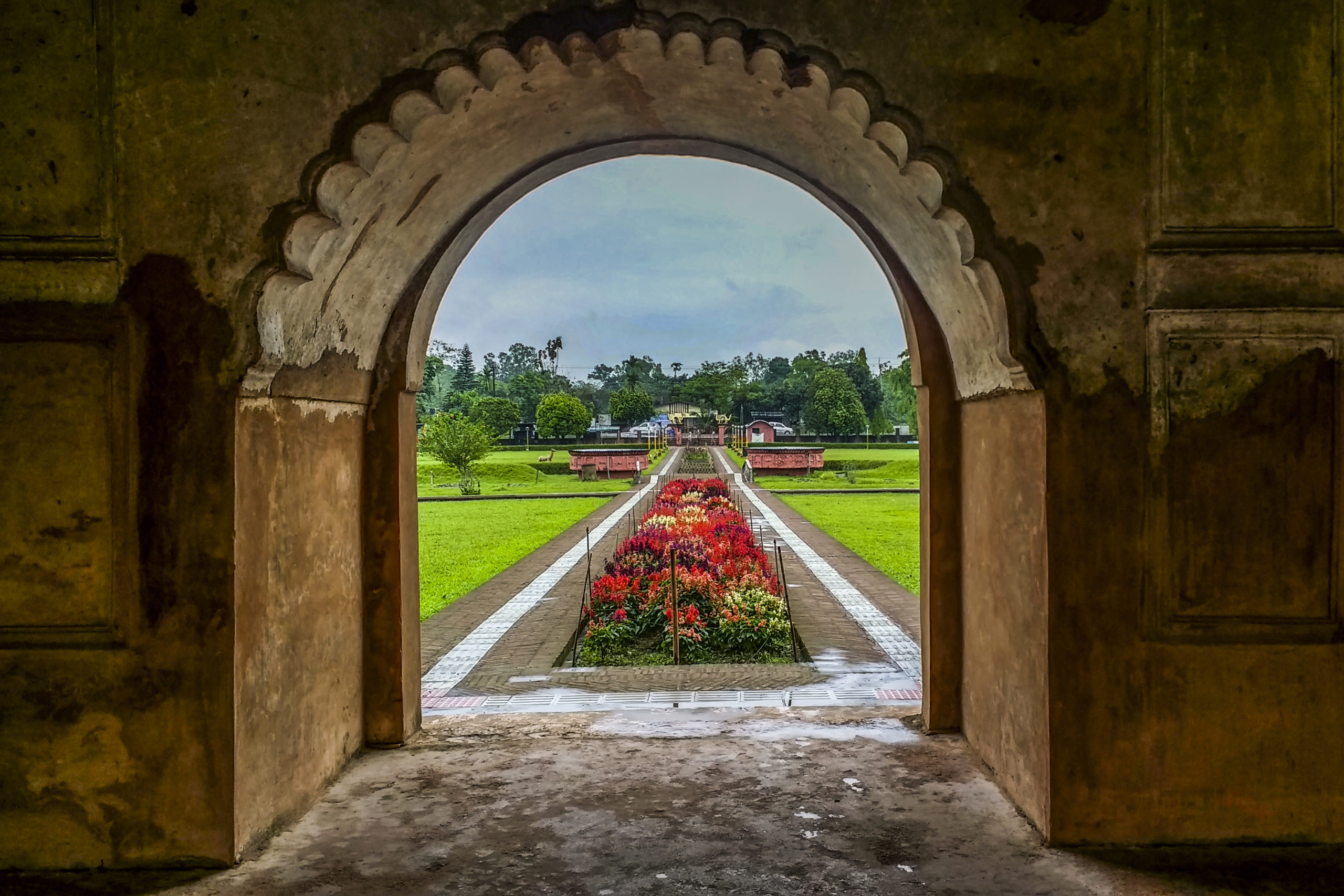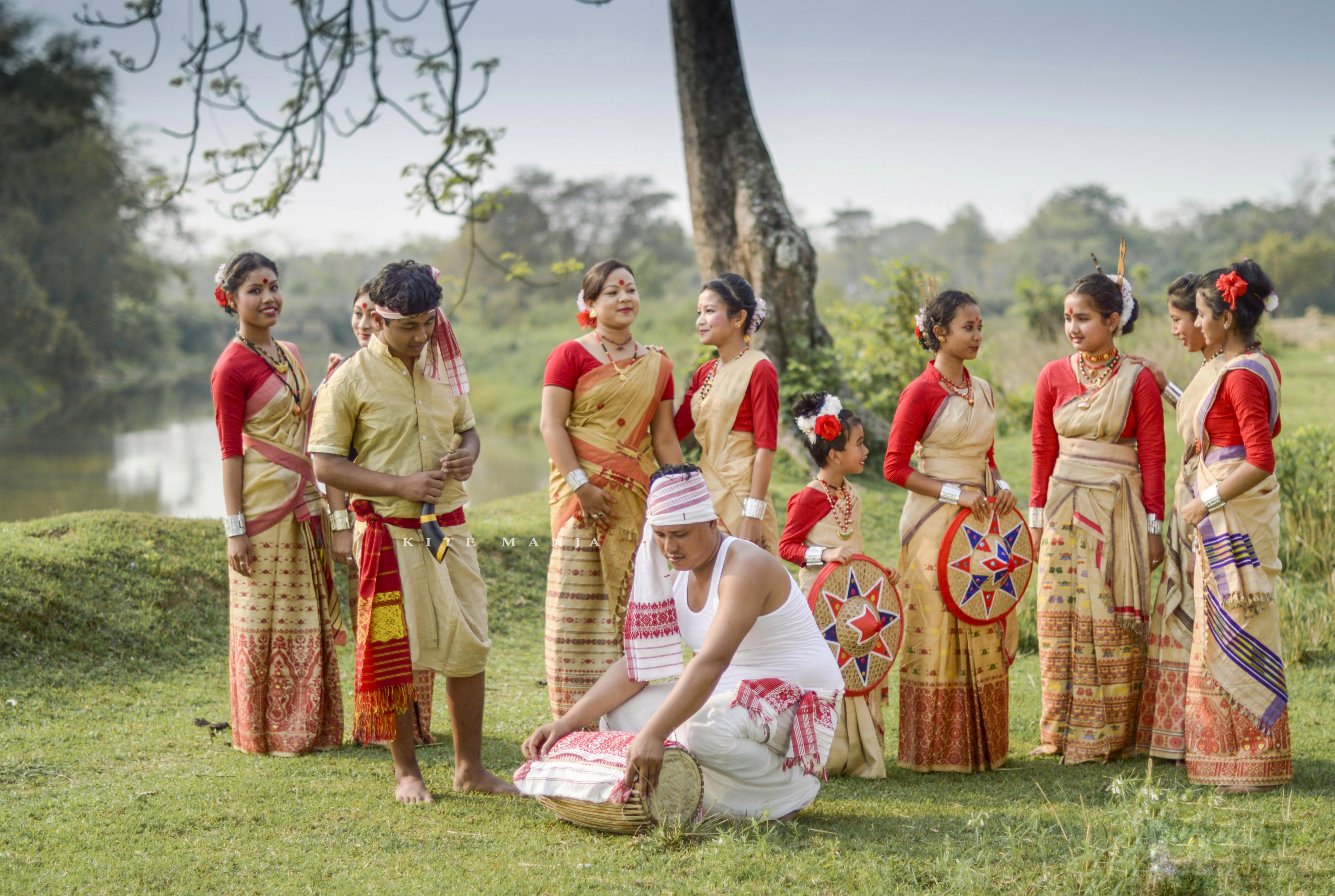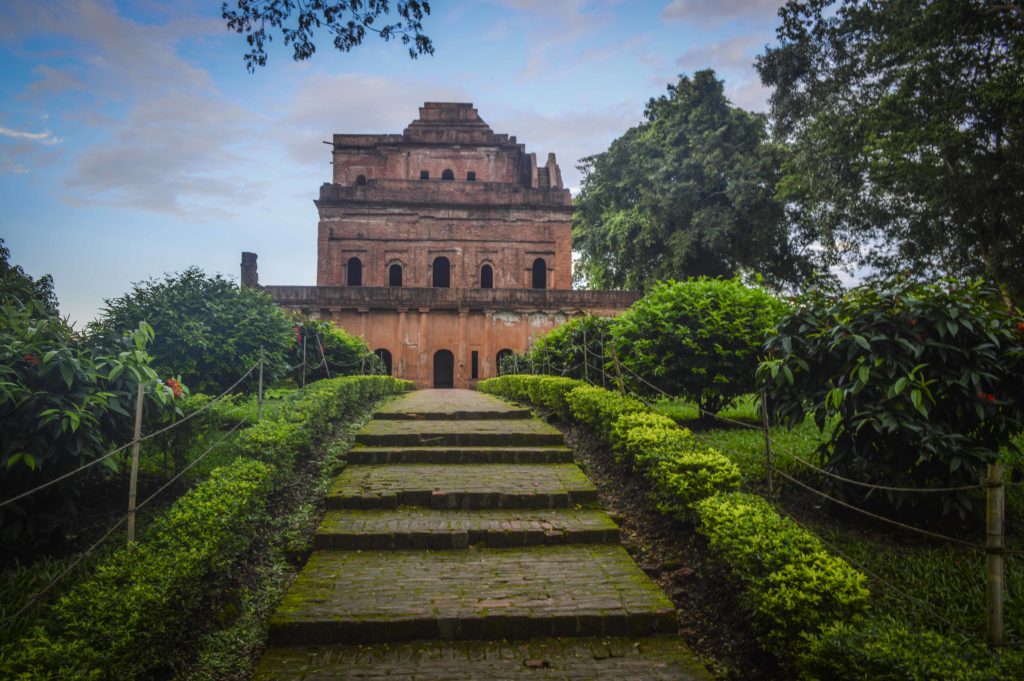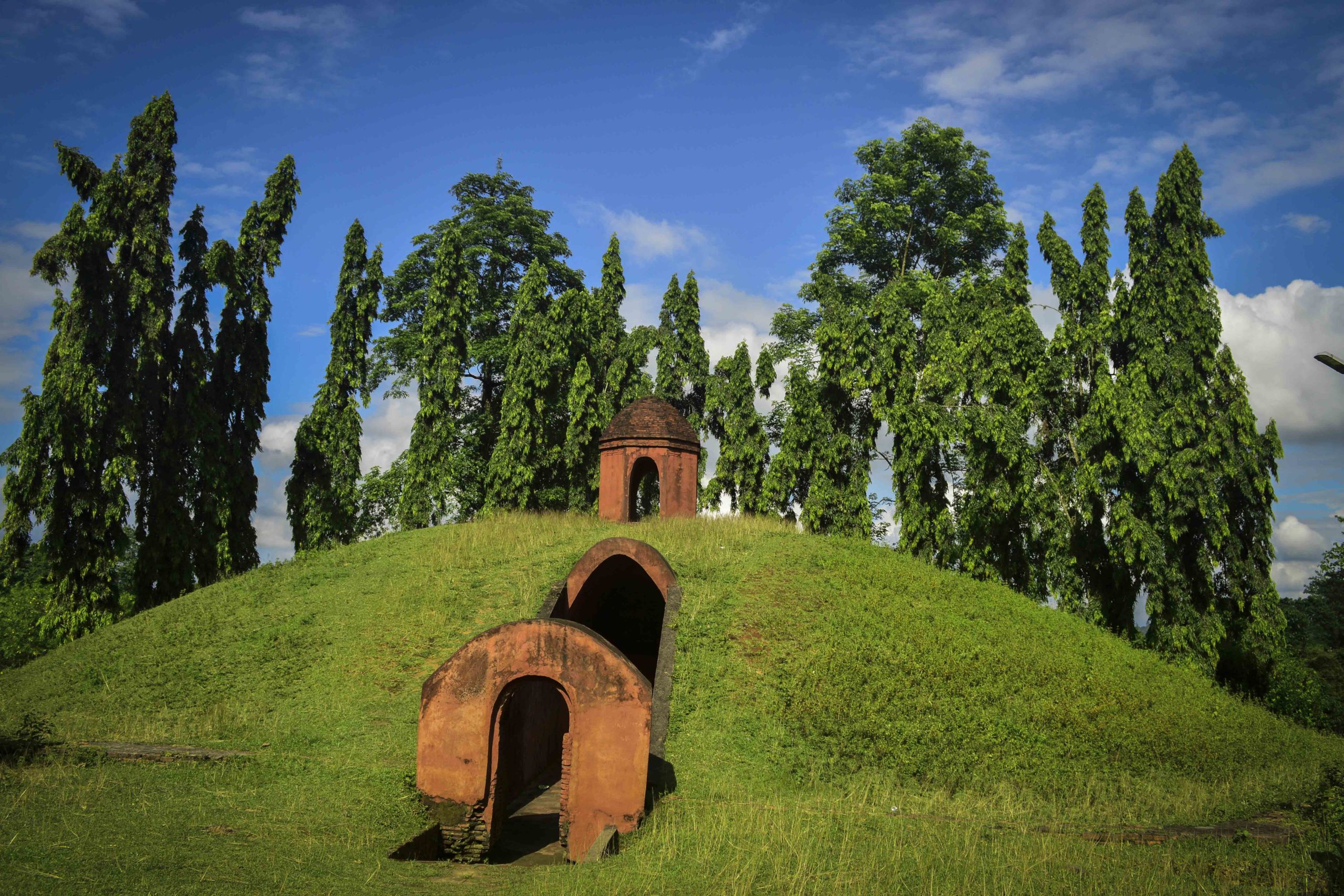As a tour operator for Northeast India, we believe that a trip to Assam is incomplete without visiting Sivasagar. It was one of the five erstwhile capital of the Ahom kingdom of Assam which testifies its glorious past and magnificent heritage.
This town is bestrewed with the archaeological sites of the Ahom dynasty. It will captivate your senses with its century-old amphitheater, water tanks, well-preserved temples and palace ruins. Not to forget the verdant tea estates and the sunset in Burha-Dhing river that makes it a perfect destination for a soulful trip.
Recently the Government of India has announced that the Sivasagar will be made an iconic destination for holistic tourism development. In our blog, you will learn about what makes this town so fabled and fabulous.
Why Sivasagar is known as the “Heritage Capital of Assam”?
Architectural Heritage of Sivasagar
In ancient times Sivasagar was once known as Rongpur. Established by the King Sukhrungphaa or Swargadeo Rudra Singha (Hindu name) in 1707, it was the fourth capital of the great Ahom kingdom. Under his regime, Sivasagar has witnessed the most glorious period of the Ahom dynasty.
The king was very instrumental in developing the cultural and architectural prowess of Rangpur, the present-day Sivasagar. During this time, mammoth man-made water tanks, palaces and temples were constructed around his capital.
Such monuments can be described as an amalgam of various cultures, traditions and religious influences. You will find distinct architectural styles ranging from domes and arches inspired by Mughal architecture to huge shikhara which are also the key elements of traditional Hindu architecture.
Over time, they even developed the technique of making organic cement by using eggs, fish, molasses, pulses and lime due to which their structures are still very strong and earthquake resistant.
An archaeologist, Mr. Milan Kumar Chauley in his journal ‘Ahom Monuments – An Architectural Marvel (New Perspective)’ has also mentioned that:
“As whole of Northeast falls in highly seismic zone, in the last 500 years at least 14 big earthquakes are recorded to have taken place in Assam (Hazarika 1990: 32-33) (The earthquakes took place in the years 1548, 1598, 1601, 1642, 1660, 1696, 1732, 1759, 1770, 1838, 1842, 1875, 1897, 1950). This very fact gives an insight into the fact that the Ahoms very judiciously used the available resources for making their structures earthquake resistant. This is evident from the fact that the extant monuments at Sivsagar have withstood at least 8 to 9 earthquakes including the last i.e. 1950, Which is believed to be one of the world’s most devastating earthquakes; when even the Assam type houses collapsed in that area, the Ahom monuments have withstood them with minor damages.”
Imagine how advanced were the Ahoms in the matter of science and art of architecture which made their monuments hold out against earthquakes to exude the saga of their illustrious past.
Cultural Heritage of Sibsagar
Initially, the Ahom clan who migrated from the Mong Mao province of Southern China used to follow a religion based on ritual oriented ancestor worship. Later Swargadeo Rudra Singha embraced Hinduism and over the time other religions too flourished in his capital. He also adopted Assamese as an official language of the Ahom kingdom.
The Ahom rulers were also a strong proponent of sports, dance and music. The king commissioned the construction of ‘Rang Ghar’ (a house of entertainment) in 1747 AD which is now believed to be one of the oldest surviving amphitheatres in Asia. It was at this place where Bihu was fostered as a cultural identity of Assam.
Sibsagar was once a majestic city and it has witnessed some of the most remarkable transitions in the cultural history of Assam. From archaeology to culture it speaks loud about the deeds of the great Ahom rulers who shaped the future of the Brahmaputra Valley. Such illustrious past and intangible splendours make Sivasagar the heritage capital of Assam.
Places of Interest around Sivasagar Town
Sibsagar Tank and Group of Temples: Sivasagar has been named after the town’s main attraction, the Sibsagar tank/ Borpukhuri (in Assamese) surrounded by its three Hindu temples. It is an architectural masterpiece that stands at a higher elevation than the rest of the town. There is a lot more for travellers in this heritage city to explore.
Located at the heart of the town, it is a large manmade water tank which is considered to be one of the oldest structures in all of Assam. Commissioned by Queen Ambika (the wife of King Sutanphaa or Swargadeo Shiva Singha, the eldest son of Swargadeo Rudra Singha) in 1734 AD, Sibsagar tank highlights the advanced hydrology skills of the Ahom period. It is built on an area of 257 acres and the depth of water is 27 feet. Interestingly, the water level of the tank never changes at any time of the year and even in the monsoon season.
Sibsagar tank is surrounded by a cluster of temples known as Siva Dol (temple dedicated to Lord Shiva), Vishnu Dol (Temple dedicated to Lord Vishnu) and Devi Dol (Temple dedicated to goddess Durga) and a Tai Ahom museum. Sivadol is also the tallest of all Shiva temples in India.
During the winter season, a lot of migratory birds also take shelter in the Sibsagar tank and a watchtower is located on the eastern bank of the tank.

Rang Ghar: This double-storeyed building is considered as one of the oldest surviving amphitheatre and sports pavilion in Asia. In Assamese language, Rang Ghar means a “House of Entertainment”. Here the Ahom kings and their nobles used to watch buffalo fights, cockfights and other sports and dance forms, particularly during the Rongali Bihu festival.
It was first built under the reign of Swargadeo Rudra Singha with bamboo and wood and later it was rebuilt by King Sunenphaa or Swargadeo Pramatta Singha (youngest son of Swargadeo Rudra Singha) between 1744-1750 AD. The building displays a typical Ahom architecture which consists of an oval amphitheatre with a roof in the shape of an inverted Ahom longboat. Thin bricks and organic cement were used to keep the interior cool throughout the year.
Talatal Ghar: Talatal Ghar in the Assamese language means an underground home. It was commissioned by Swargadeo Rudra Singha in 1698 AD and it happened to be the military base of the Ahom kingdom. Till date, it is considered the largest of all the Ahom architecture.
Talatal Ghar has three floors below ground level and two secret tunnels which were used as exit routes by the royal family in case of any distress. It is situated close to Rang Ghar and Joysagar Tank and nowadays only the upper portion of the monument is accessible to the tourist. The floors below the ground are sealed off.
Jaysagar Tank: You will be surprised to know that Jaysagar tank is the largest manmade tank in India covering an area of 318 acres. Jaysagar was built by Swargadeo Rudra Singha in the memory of his mother, Jaymati. It is said that this huge pond was excavated in just 45 days if this speculation is true then imagine how advanced were the Ahoms in hydrology even in that era.
The sunset from Jaysagar is magnificent! Book a table at the ‘Heritage Jaysagar’ to adore an immaculate view of the setting sun where the whole landscape blooms in the shades of red and orange. There is even a cluster of temples dedicated to Lord Vishnu, Lord Shiva, and Lord Ganesha to name a few.
The most famous amongst all is the temple dedicated to Lord Vishnu known as ‘Kesavanarayan Vishnudol’ or ‘Jaydol’. Known for its architectural artistry, Vishnudol is the largest temple built by the king in an adaptation of a unique ‘Nilachala Style’ of architectural design. This design first was used by the Koch King Naranarayana to rebuild the Kamakhya temple in Guwahati in 1562 AD. These are the only two temples in the world using the Nilachala style of architecture.
Kareng Ghar: Little away from the Sivasagar town at a distance of just 15 km is the formidable Kareng Ghar, also known as the Garhgaon Palace. Gargaon used to be the kingdom’s capital for more than four centuries before shifting it to Rangpur. The Kareng Ghar is the last remains of the royal palace of Ahom rulers in Gargaon and is the grandest monument that they have ever made.
It is a four-storeyed building with gradually receding floors. It is believed that there is a secret underground tunnel from ‘Kareng Ghar’ to ‘Talatal Ghar’ in Sivasagar across the river Dikhow.
Charaideo: Almost 30 km away from the Sivsagar town remains the sacred burial mounds of Ahom kings and queens at a place called Charaideo. This place portrays the symbol of Ahom power and it is also the place of ancestral Gods of the Ahom. In Tai Ahom language Charaideo means ‘the shining city on the hills’ and it is the first capital of the Ahom kingdom founded by King Chao Lung Sui-Ka-Pha in 1253.
Ajan Pir Dargah: About 22 km from Sibsagar town at Sonpura, Gargaon lies the revered Ajan Pir Dargah dedicated to a great Muslim reformer and a Sufi saint Shah Miran. He got the name as Ajan Fakir because of his style of chanting Azan, the calling for ‘namaz’. He migrated from Baghdad to India in the 17th century and later settled in Sivasagar. He was the disciple of Khwaja Nizamuddin Auliya and stressed in love as a means of realising God.
Ajan Pir is well known for his Zikir (a type of spiritual song) that helped reform, and stabilize Islam in Assam. The mausoleum was commissioned by King Supatphaa or Swargadeo Gadadhar Singha after his death. It is a divine place and you will feel a sense of inner peace.
Panidihing Wildlife Sanctuary: This bird sanctuary is just 22 km from the Sivsagar town. Spread over 33.93 square kilometer, it is surrounded by the Brahmaputra and the Dishang river in the northwest and to the south. There are about 270 species of birds including 70 migratory birds have been recorded in Pani Dighing. It is a must-visit place for a wildlife photographer travelling in Sivasagar.
Dichang Mukh: Nestled on the confluence of Rivers Dichang and Brahmaputra, Dichang Mukh is a scenic Mishing tribe village situated about 10 km from Sivsagar town. This riverine settlement is an upcoming village tourism destination in Assam which portrays the true cultural essence of the Mishing people. The traditional houses made on stilts, the rural ambience and simple lifestyle offer an immersive experience to the visitors. The view of the sunset from Dichang Mukh is a great place to watch the sun vanish into pristine waters. Ethnic lunch with a local Mishing family, sandbar camping and birding during the winter season are some of the highlights of Dichang Mukh.
Patsaku Village: Patsaku is a must-visit destination if you want to know about the Tai-Ahom culture, history and tradition. Although the village has accepted a new age lifestyle, it has not detached itself from its actual cultural roots. This is the only place in Assam where the Ahoms have preserved their Tai language. The age-old identity of the Ahoms in the form of rituals, dance, dress, textile and cuisine is still prevalent in Patsaku. On a day outing to Patsaku, you can learn about the primitive ways of Muga silk yarning, a short history lesson about how Sukaphaa entered the Brahmaputra valley and established the Ahom kingdom and an introduction to culinary arts of the Tai Ahom people.
How to Travel to Sivasagar?
Sibsagar town is well linked to the major parts of Assam. You will find the nearest airport at Jorhat and Dibrugarh. It also has a railway station called Sibsagar Town Railway Station. By road, it is well connected with major cities and this town is a good layover for people traveling to Mokochung in Nagaland to see the few remaining Konyak head-hunters.
Sibsagar town and its neighbouring areas are dotted with rich cultural and architectural heritage. A visit here will introduce you to the historical legacy of the Ahom kingdom, the longest-ruling dynasty in all of India. If you are planning to visit soon then drop us an email at info@kitemanja.com and we as a local tour operator would love to show you our beautiful Sivasagar – The Heritage Capital of Assam.







